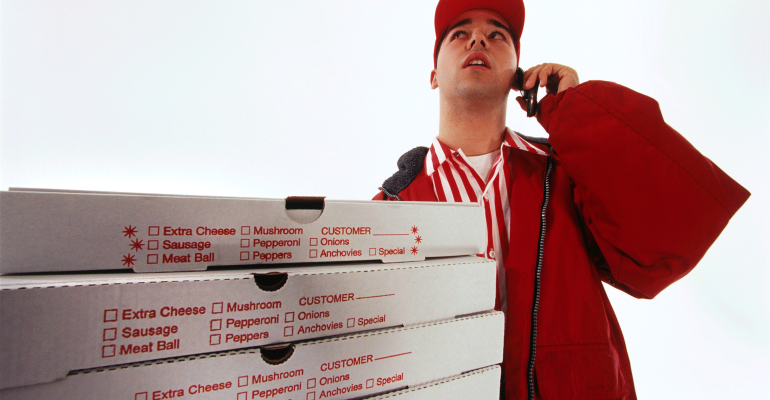 This post is part of the On the Margin blog.
This post is part of the On the Margin blog.
The biggest trend in the restaurant industry is delivery. Thanks to the growth of third-party delivery providers, restaurant chains are falling all over themselves to bolster that business, despite concerns about profitability and the impact on operations during peak times.
Meanwhile, the pizza segment has recently shown some weakness.
On Tuesday, Papa John’s International Inc. said its North America same-store sales increased 1 percent in the third quarter, and warned of further weakness this quarter.
On Thursday, Yum Brands Inc.’s Pizza Hut said same-store sales were flat in the quarter ended Sept. 30. That’s actually an improvement for Pizza Hut, but still.
Meanwhile, earlier this quarter, Domino’s Pizza Inc. said same-store sales increased 8.4 percent. That's a strong number that likely will be the strongest same-store sales figure any restaurant chain reports this quarter. But it’s not in the double digits, which just shows you how strong Domino’s has been of late.
Take them all together and you have a segment that appears to be losing a little steam. Given the immense number of advantages all three of these chains have over their smaller, independent competitors, they theoretically should be performing better — poor NFL ratings or not.
Which brings us to the question: Is the pizza segment showing the impact of the growth in delivery? And is this what we can expect as delivery continues to grow?
Greg Creed, Yum! Brands’ CEO, was non-committal when asked on Thursday morning’s earnings call. But he acknowledged that competition in the delivery space is growing fierce.
“I think a lot of people are trying to get into the easy delivery business,” Creed said. “Competition is heating up in this area."
However, Pizza Hut has been aggressively improving its own performance, he said, by working on speed, hiring more drivers and investing in technology to make it easier for customers to order. The improvements “keep us competitive in this marketplace.”
Investors are growing increasingly concerned about the prospect of delivery hurting pizza. Domino’s stock, for instance, is down 15 percent since it released third-quarter earnings.
Howard Penney, analyst with Hedgeye Risk Management, has said that encroachment of delivery providers — and, in particular, McDonald’s Corp.’s aggressive moves to expand delivery — is bad news for Domino’s.
The bigger question, however, is whether overall demand for delivery is increasing, or whether the increasing use of third-party providers is taking some business away from the more established players. The guess is that it’s some combination of both, and that the pizza players can indeed expect increasing competition from outside their space.
Remember, the overall delivery market in the U.S. was relatively tiny before companies like DoorDash and Uber Eats began entering the space. Even then, a certain percentage of customers at these companies simply prefer picking it up themselves. (Full disclosure: I’m one of them.)
Restaurant companies that are generating delivery business say almost exclusively that delivery is a “new occasion” for them, including Creed, who spoke about his company’s KFC and Taco Bell concepts.
Historically, most of the U.S. has had limited availability of delivery options. Generally, they’ve consisted of pizza and Chinese food. As such, the sudden and rapid increase in availability of newer and different options could take some business that would have otherwise simply ordered some pizzas.
This is probably reflected in McDonald’s early experiences with delivery. The company said much of its delivery orders come at night, which is when many pizza chains get their business. But, pizza chains also have immense advantages, as Domino’s displays time and again.
Pizza chains provide their own drivers and have long, well-established systems already in place. They have used technology far more effectively than have other restaurant companies, making it easier to order. And according to an AlixPartners study earlier this week, consumers strongly prefer ordering delivery from the company and not from a third party.
Third-party delivery also costs money. And consumers generally prefer not overspending for their meals. Pizza remains arguably the best value in the restaurant industry.
Also, demand for convenience remains perpetually on the upswing. That’s the fundamental element of the current market. People want their food at home — regardless of which company is providing that food. That has led to the influx of fast-casual chains. It’s also led to rapid increases in takeout orders at casual-dining restaurants.
Jonathan Maze, Nation’s Restaurant News senior financial editor, does not directly own stock or interest in a restaurant company.
Contact Jonathan Maze at [email protected]
Follow him on Twitter: @jonathanmaze





